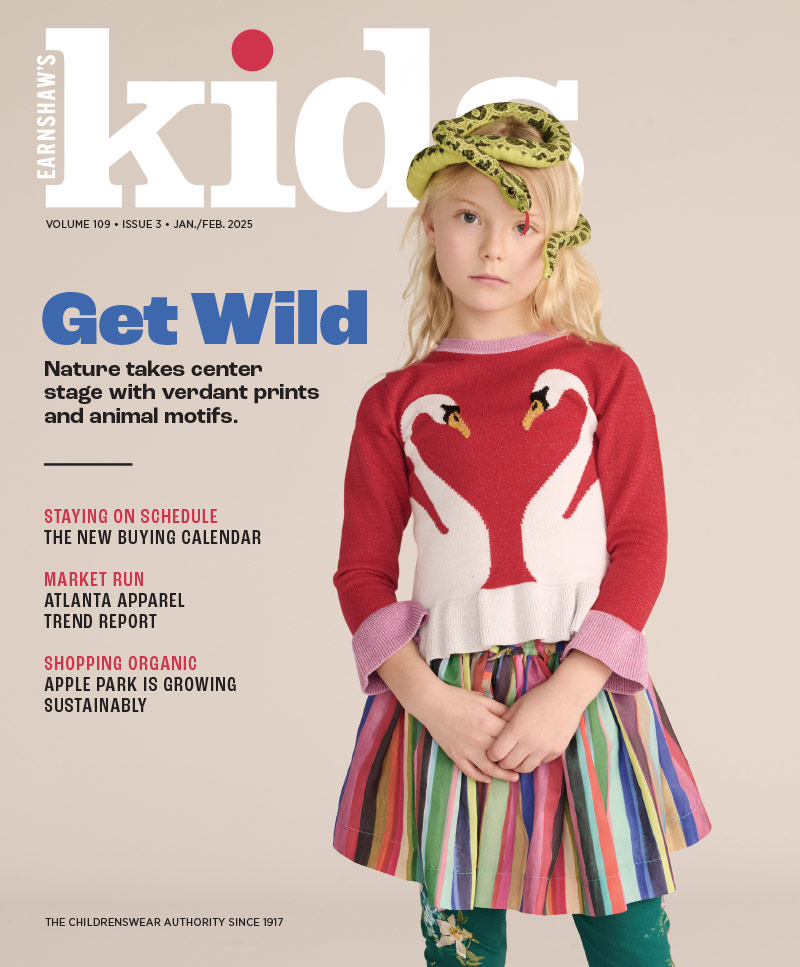With swimwear sales on the rise, now is the time for children’s retailers to use smart tactics to boost business. By Audrey Goodson Kingo The water’s fine for the swimwear category, with worldwide sales of swimsuits and beach apparel predicted to grow 3.1 percent annually and hit $19.4 billion by 2018, according to market research […]
With swimwear sales on the rise, now is the time for children’s retailers to use smart tactics to boost business.
By Audrey Goodson Kingo
The water’s fine for the swimwear category, with worldwide sales of swimsuits and beach apparel predicted to grow 3.1 percent annually and hit $19.4 billion by 2018, according to market research firm Global Industry Analysts. What’s behind the spike? High-tech fabrics and increased interest in health and fitness are two factors, but the firm also credits swimwear brands for incorporating more fashion elements into suits, particularly in the children’s market.
Tania Snyder, owner of Kids Klothesline, a children’s boutique based in Perrysburg, OH, says those fashion details are precisely why parents are willing to pay a premium for specialty swimwear: “The other kinds of suits you can find anywhere,” she notes. And while mass swim labels may eventually copy the fancy flourishes found on boutique brands, “you can’t get the same look with a cheaper blend of fabrics,” she points out. Plus, elements like UV-protective fabric and a full line of coordinating accessories make today’s swimwear too tempting for parents to pass up. Surf’s up—are you ready to ride the wave?
1 – It’s a Girl’s World
It’s no secret to longtime swimwear sellers: Girls’ suits and accessories make up the bulk of the category. Snyder recommends retailers maintain an 80-20 assortment ratio, with the majority focused on girls’. In fact, it’s an industry-wide guideline. Terra Fazzio, president of New York City-based Thread Showroom, says that no matter the size of a brand’s boys’ swim collection, her retailers almost always make sure around 80 percent of their store’s swimwear selection is geared toward girls.
2 – Remember Ruffles, Rosettes and Neon
When it comes to what little girls love, more is always more. “The swimsuits we really do the best with are the ones that look like dress-up clothes,” Snyder says. In other words, you can’t go wrong with ruffles and other eye-catching embellishments. LaDonna Felke, the buyer for LaBella Flora, an online children’s boutique, says, “Anything with rosettes right now is very popular.” Beaded swimwear, she adds, has been a hit with tweens.
Even customers who prefer a more streamlined look, like the Stella Cove suits Fazzio stocks in her showroom, appreciate a pop of color, or an original print. “What we’re seeing is any of the conversational prints doing very well, whether that’s a funny graphic like a rubber ducky or a beautiful flower,” she notes. “And what we’re seeing trend-wise are neon trimmings. We’re doing very well with those.”
3 – Revisit the Past
Filtering down from the womenswear market, where high-cut ’50s-style bikinis are big sellers, anything with a retro flair is faring well, retailers report. “We did really well with a vintage-inspired line this past season, Chichanella Bella. Yes, it had a high price point, but it sets itself apart,” Snyder says of the collection, which retails for around $76 a suit. “That was my first order, but I’ll definitely order it again,” she asserts.
“A surprise to us is how well one-pieces are selling,” says Kristin Swati, owner of the Fawn Shoppe, an online children’s boutique based in New York City. Swati believes the move toward more modest silhouettes is a reflection of the market’s shift toward vintage-inspired designs. Other signs of the shift? Classic swimwear prints featuring sailboats and anchors are a bestseller for Stella Cove, Fazzio notes. And vintage-inspired pin dots prints, like the Jenny Annie Dots suit by Kate Mack, are bestsellers at LaBella Flora, Felke says.
4 – Swim All Year Long
Spring and summer are a no-brainer when it comes to stocking swimwear, but many retailers now note that the fall and winter months are becoming increasingly crucial selling seasons. Swati suggests retailers carry swimwear all year. “I think that gives you an advantage because there are obviously people looking during resort season,” she points out. “They may become loyal to you because you were there when others weren’t.”
If you don’t have the floor space to maintain a year-round swim section, then timing is key when it comes to displaying the latest spring/summer styles. “Get them in early—sometimes we like them even in December,” Snyder advises, wisely adding, “No one is sad to see spring/summer and vacation clothing.” Fazzio seconds that suggestion: “The resort delivery is very important, so getting the goods in around mid-November for people who are traveling is really important. If people miss it the first time around, they may not know you are a swim destination,” she points out.
5 – Accessories are a Must
From sunglasses and sandals to hats and rash guards, swimwear accessories aren’t simply a nice add-on sale—they are essential to your store’s bottom line. “We do as well with our accessories, I would say, as we do with our swimwear,” Felke reveals. “We find that we do well when we offer coordinating pieces, such as sandals, flip-flops or cover-ups. Sometimes parents want the full ensemble for the pool or the beach,” she points out. Cover-ups do especially well in cooler climates, she adds, where evenings can be a bit chilly even in the summer. For Snyder, Kate Mack and Jamie Rae Hats are a hit at her store, as are sunglasses by Teeny Tiny Optics.
“The top suggestion I would make to retailers is to create an overall beach look,” Fazzio says. That’s why she is particularly excited about Stella Cove’s new line of espadrilles, featuring prints that match the brand’s most popular suits. (The shoes begin shipping in November.) “In order for your swimwear to have a better representation, and something that gets your customer excited about resort wear, have the whole look,” she adds.
6 – Parents Love Sun Protection
“One thing I would say is becoming more and more popular is anything with UV protection or greater sun protection,” Swati shares. The Fawn Shoppe did well with a navy rash guard from Stella Cove, and Swati plans to add more to the mix next year. “It’s cut so that it can go with the boys’ fitted shorts or go over the bathing suit,” she points out. However, Snyder cautions that just because suits are UV-protective doesn’t mean they are guaranteed to sell. While Kids Klothesline did well with a Hawaiian line of rash guards, the brand’s protective suits didn’t fare as well at retail. “The suits were really cute, but they didn’t have those special boutique stylings, like cut flowers, rhinestones and tutus, and they didn’t sell as well for us,” she reveals.
Before diving into the category, Swati suggests considering the concerns of your consumer, as eco-minded parents may be put off by some of the protective gear on the market. “Some of those fabrics are sprayed with chemicals, and if you get those chemicals in the sun, I personally wouldn’t want to put that on my child. I try to stay away from anything that’s chemically treated, especially for kids,” she says.
7 – Size It Up
“Talk to your customers about how each brand fits differently,” Felke advises, noting that swimwear for many European brands tends to run smaller than their U.S. counterparts. “We recommend as a general rule ordering a size up. A lot of moms or grandmothers aren’t usually aware that swimwear needs to be a size larger than their usual clothing,” she points out.
And Fazzio suggests carrying an assortment in larger sizes, too, even if your store primarily caters to tots. “Don’t forget about the teenagers,” she says. “We sell a lot of tween and 12/14/16, both for larger children and for teenagers who aren’t quite there yet for women’s bikinis, but don’t want to wear kids’ bikinis, either.”




 FASHION IS MY PLAYGROUND
FASHION IS MY PLAYGROUND 
 The Chi
The Chi



 The
The

 The top expo for kids and baby
The top expo for kids and baby
 The 2025 Earnie Awards are officially OPEN! I
The 2025 Earnie Awards are officially OPEN! I


 From milestones to everyday magic, @ryleeandc
From milestones to everyday magic, @ryleeandc

 BEST IN SHOW: @milaandrose
Twirl-worthy, pla
BEST IN SHOW: @milaandrose
Twirl-worthy, pla





 This season’s
This season’s




Leave a Comment: